We test all of the best smartphones at Digital Trends to find out exactly what they’re capable of, and we look for all of the best models available. To find the best Android phones, we divided this list into categories based on various signature attributes and budgets. For each, we offer our top pick and any alternatives we think are worth mentioning. We chose the Samsung Galaxy S22 Ultra as the best Android phone since it has a superb camera, a beautiful screen display, and impressive battery life.
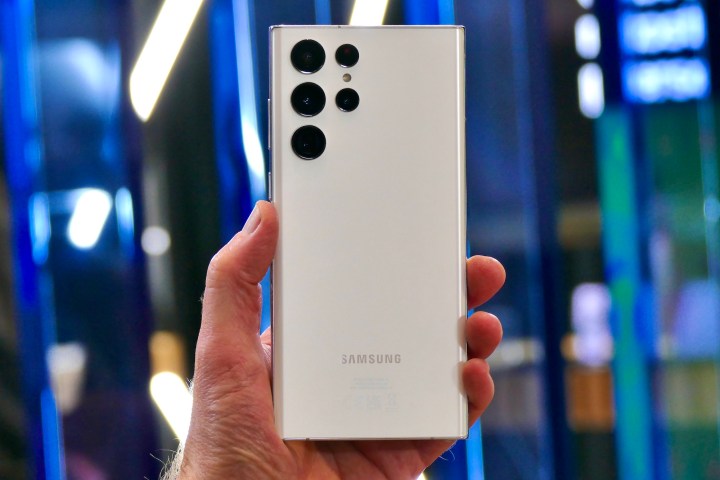
Andy Boxall/Digital Trends
Samsung Galaxy S22 Ultra
Best Android phone
Pros
- S Pen is convenient and highly accurate
- Versatile camera takes great photos
- The latest processor for power
- Long software support
- Beautiful high refresh rate screen
Cons
- Not very fast battery charging
- Large and heavy
Why you should buy this: The Galaxy S22 Ultra is a gorgeous hunk of phone with every panel and line perfect in fit and finish.
Who is it for?: Buyers who seek the safest, most forward-looking phone purchase available.
Why we picked the Samsung Galaxy S22 Ultra:
The Samsung Galaxy S22 Ultra is a tough phone that will last for years. It’s all business with flat end caps, sharp lines, and squared-off corners — not the friendliest design, and not the easiest to handle, but solid. At 228 grams, it’s one of the heaviest smartphones out there, but it’s stylish and sleek despite all that.
The Galaxy S22 Ultra’s huge screen is arresting with beautiful colors, deep blacks, and features like HDR10+ and Dolby Atmos for multimedia. The same Armor Aluminum metal used on the Galaxy Z Fold 3 and Galaxy Z Flip 3 constructs the chassis, paired with Gorilla Glass Victus+. Its 6.8-inch Dynamic AMOLED screen has a 120Hz refresh rate and a maximum resolution of 3088 x 1440 pixels with a peak brightness at 1,750 nits. Samsung promises four Android version updates and five years of security updates for superlative longevity.
The Galaxy S22 Ultra comes with an S Pen stylus nestled within a storage slot on the bottom of the phone, letting you take neat, hand-written notes using the stylus and the screen. The camera lenses are individually set in the back panel in an attractive, minimalist design. The camera takes beautiful photos with vibrant colors and balance, with an updated, customizable portrait mode, and otherwise gets the job done with a variety of versatile high-quality optical zoom modes plus the main and wide cameras.
It runs on the Qualcomm Snapdragon 8 Gen 1 processor. The cheapest model comes with 8GB of RAM and 128GB storage space and does not support a MicroSD card. The battery is rated at 5,000mAh, and Samsung has equipped the phone with support for 45-watt fast charging (block not included in the package).

Samsung Galaxy S22 Ultra
Best Android phone
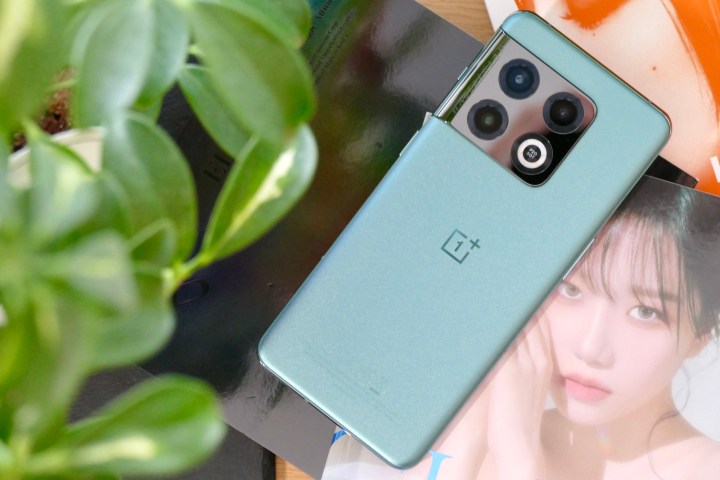
Andy Boxall/Digital Trends
OnePlus 10 Pro
Best runner-up Android phone
Pros
- Attractive and well made
- Interesting camera features
- Fast battery charging
- Bright and colorful AMOLED screen
Cons
- Unreliable software
- No water resistance
Why you should buy this: It’s a capable, attractive, affordable phone.
Who it’s for: Anyone looking for a solid, pocket-friendly dependable phone.
Why we picked the OnePlus 10 Pro:
Even with the OnePlus 11 around the corner, the OnePlus 10 Pro is still a killer package. The OnePlus 10 Pro is not what you’d call petite. It measures 8.6mm thick and at 200 grams, it’s got that chunky look and feel — but not in a bad way. With a pro-level build quality and metal chassis, its front is covered in Gorilla Glass Victus, and its back in Gorilla Glass 5, complete with a grippy frosted finish exterior.
The view on the screen reflects a 3216 x 1440 pixel resolution at 525 pixels-per-inch (ppi), a billion colors, and HDR10+. Its dynamic 120Hz refresh rate gets an assist from the LTPO 2.0 AMOLED panel. The handset comes with 12GB RAM and 256GB storage running on a Qualcomm Snapdragon 8 Gen 1 processor.
The camera is made in conjunction with Hasselblad’s second-generation Camera for Mobile software and it is paired with a 48-megapixel main camera, a 50MP wide-angle camera with a 110-degree field of view, and an 8MP telephoto with 3.3x optical zoom. It also has a 150-degree wide-angle camera mode.
The OnePlus 10 Pro has a 5,000mAh dual-cell battery and U.S. retailers sell it with a 65W SuperVOOC charger.

OnePlus 10 Pro
Best runner-up Android phone

Andy Boxall/Digital Trends
Samsung Galaxy A53 5G
Best cheap Android phone
Pros
- Pretty design
- IP67 water-resistance
- Camera is great for social media
- Vibrant screen
- Two-day battery life
Cons
- Performance can be sluggish
- Not an upgrade to the A52 and A52S
Why you should buy this: The reasonably priced Galaxy A53 5G is a high-quality phone for any user that seeks good value.
Who it’s for: Anyone wanting a budget phone with a stylish exterior and good performance.
Why we picked the Samsung Galaxy A53 5G:
In concert with its lower price, the Samsung Galaxy A53 5G is constructed of plastic and Gorilla Glass and measures 8.1mm thick at 189 grams. The plastic back does not look or feel cheap but rather has a pleasing, grippy texture, which conveniently repels fingerprints and smudges.
The phone runs on a Samsung Exynos 1280 octa-core processor and is available with 6GB or 8GB RAM and 128GB or 256GB of storage. It also has space for a MicroSD card slot. The 6.5-inch Super AMOLED screen has a 2400 x 1080 pixel resolution with a 120Hz refresh rate.
The Galaxy A53 5G’s camera system looks stylish and works great. The four cameras include a 64MP main camera with an f/1.8 aperture, a 12MP wide-angle camera, and two 5MP cameras for macro and depth. There’s also a 32MP selfie camera at the top center of the screen. Features include Night mode, Pro mode, Single Take mode, and video recording up to 4K and 30 fps or FHD at 60 fps. It includes various Snapchat Lenses and augmented reality effects.
The A53’s 5,000mAh battery lasts for two days if you’re not a hardcore gamer.

Samsung Galaxy A53 5G
Best cheap Android phone
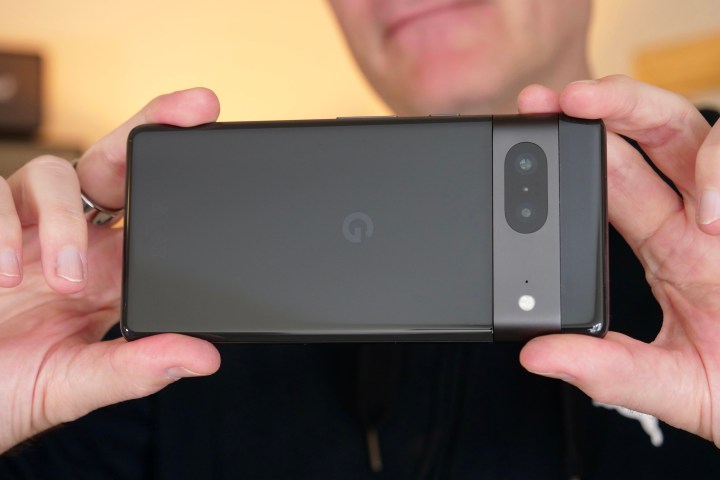
Andy Boxall/Digital Trends
Google Pixel 7
Best value Android phone
Pros
- Superb camera
- Long battery life
- Eye-catching design
- Vibrant screen
- Years of software updates
- Fantastic price
Cons
- Slow charging
- Software bugs
- Poor gaming performance
Why you should buy this: The Pixel 7 features a winning combination of a great camera, long battery life, and a great software experience.
Who it’s for: Anyone who seeks a reasonably priced smartphone with a great camera, excellent software, and respectable battery life.
Why we picked the Google Pixel 7:
This is a substantial smartphone at 8.7mm thick and 197 grams, encased in a smooth aluminum chassis and a Gorilla Glass Victus rear panel. It’s a bit slippery, so it needs a firm grip and a case. The 6.3-inch AMOLED screen has a 90Hz refresh rate and a 2400 x 1080 pixel resolution with HDR10+.
Two cameras sit on the back — a 50MP f/1.9 aperture main camera with optical image stabilization (OIS) and laser autofocus, and a 12MP f/2.2 wide-angle camera. The main camera is one of the best cameras on a smartphone. It supports video at 4K resolution up to 60 frames per second and 10-bit HDR. The front carries a 10.8MP f/2.2 aperture selfie camera. The Pixel 7’s main camera produces sharp, visually punchy photos while Night Sight mode pictures bring out plenty of detail.
The Pixel 7 runs on Google’s new Tensor G2 processor and comes with 8GB of RAM and either 128GB or 256GB of storage. Android 13 comes installed. The handset only has a 4,355mAh battery, but that still provides robust all-day battery life.
There’s no charger in the box, but the phone supports USB Power Delivery 3.0 and promises a 50% charge in 30 minutes.

Google Pixel 7
Best value Android phone
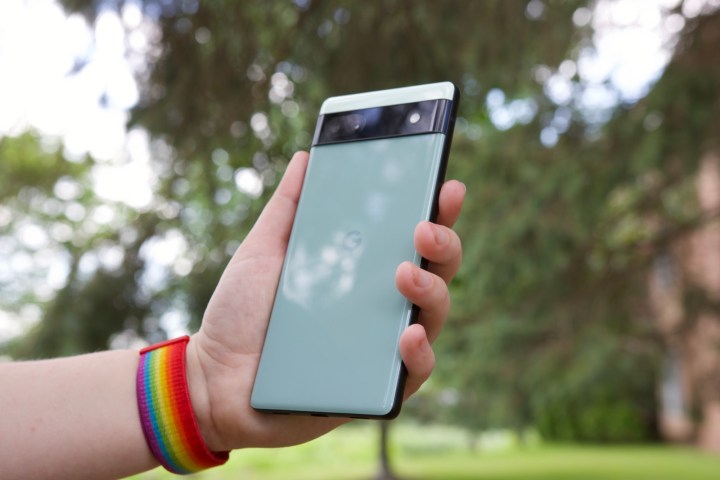
Joe Maring/Digital Trends
Google Pixel 6a
Best affordable camera Android phone
Pros
- Compact, lightweight design
- IP67 water resistance
- Flagship-grade performance
- Excellent cameras
- Clean software
- Years of guaranteed updates
Cons
- Display is only 60Hz
- Tensor chip runs hot
- Lacking battery life
Why you should buy this: The Pixel 6a delivers a lot of phone for not much money and is an excellent value.
Who it’s for: Anyone in the market for a new handset and needs to keep the price tag under $500.
Why we picked the Google Pixel 6a:
The Pixel 6a’s relatively petite form factor is derived from its 6.1-inch OLED panel — smaller than the 6.4 and 6.7-inch screens on siblings Pixel 6 and 6 Pro. The screen features an HD+ 1080 x 2400 pixel resolution, 60Hz refresh rate, and is covered with Corning Gorilla Glass 3. The back sports a two-tone design separated by Google’s distinctive top camera bar. The aluminum frame is durable while the plastic back is grippy and repels fingerprints.
The Google Tensor chip is exactly the same as in the flagship Pixel models and as a performer, it holds up to day-to-day tasks well with reliable multitasking, though the phone tends to run hot. The Pixel 6a now runs Android 13, and Google promises three years of OS upgrades and five years of security updates.
The Pixel 6a has a reliable camera phone setup. It packs an older 12.2MP camera featuring an f/1.7 aperture, optical image stabilization (OIS), and phase detection autofocus. It’s paired with a 12MP ultrawide camera with a 114-degree field of view, and an 8MP selfie camera. The phone captures great detail and punchy colors that aren’t overly vibrant and uses its HDR features judiciously.
The Pixel 6a runs on a 4410mAh battery — not exactly a powerhouse — but more like a one-day smartphone for most users. The 18W wired charging is the only option, as the phone does not support wireless charging.

Google Pixel 6a
Best affordable camera Android phone
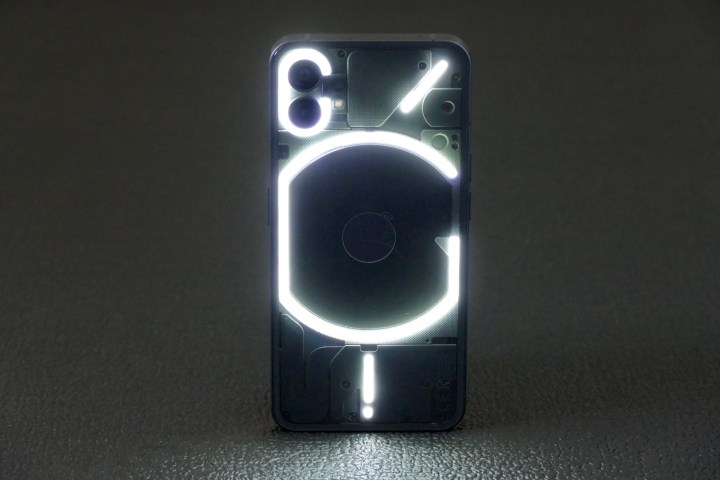
Andy Boxall/Digital Trends
Nothing Phone 1
Best designed Android phone
Pros
- Quirky and unusual design
- Slick, easy-to-use software
- Glyph Interface is eye-catching
- Main camera takes good photos
- Wireless charging
Cons
- Short battery life
- Inconsistent wide-angle camera
- Late Android 13 update schedule
Why you should buy this: Because it’s like nothing else on the market, and a good phone to boot.
Who it’s for: Someone who wants a phone that really stands out from the usual crowd.
Why we picked the Nothing Phone 1:
Outside of folding phones, it’s fair to say smartphone design has grown a little stale. Carl Pei’s Nothing has thrown a little spice into the recipe, though, with the Nothing Phone 1. While the silhouette is broadly the same as most other phones, the clear glass back and Glyph lighting mean the phone really stands out from the crowd.
The phone itself is well-sized and easily capable of being used one-handed by most people. The edges are a little sharp though, making extended periods of holding a bit more difficult. But forget all that, because it’s the back that’s the coolest part. Most of the components are covered, but the exposed wireless charging coil and panels give off strong sci-fi vibes. This is especially true thanks to the Glyph lights, which light up in different ways for different alerts and activities, including when the Google Assistant is being used. They can even be used instead of the camera’s flash. They’re something truly unique to Nothing, and a genuine reason to seriously consider the phone.
The Nothing Phone 1 is powered by the Qualcomm Snapdragon 778G+, and it provides responsive and reliable performance. It does slow down when playing games, but otherwise, that chip and 8GB of RAM keep the phone running well. The 6.55-inch display has a 120Hz refresh rate, so it’s super smooth, as well as looking great. The rear camera module has a 50MP main lens and a 50MP wide-angle lens, and it takes good photos. It’s not likely to unseat any of the best camera phones, and it struggles at night, but it’s still a capable camera with a lot to offer.
You’ll get a day out of the Nothing Phone 1’s battery, but nothing more. It’s a phone you’ll need to charge daily, and it also only has QuickCharge 3.0, which is a little underwhelming these days. Still, it’s fine as long as you’re happy to charge every day and keep a portable battery on you for more demanding days away from the charger.
The Nothing Phone 1 was originally not coming to the U.S., but after good sales, it seems to be launching there after all. In the U.K., the phone retails for 399 British pounds, so expect the phone to be around that price when it comes to the U.S. later in 2023.

Nothing Phone 1
Best designed Android phone
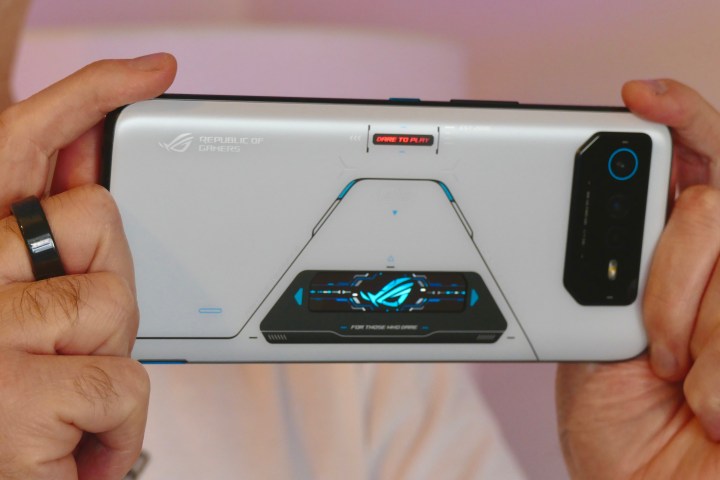
Andy Boxall/Digital Trends
Asus ROG Phone 6 Pro
Best gaming Android phone
Pros
- Immensely powerful
- Versatile shoulder buttons
- Clean, fast software
- Vibrant and big screen
- Great sounding audio
- Kunai 3 gamepad accessory
Cons
- Big and heavy
- Lacks wide appeal
- Average camera
Why you should buy this: This is the best gaming smartphone available today.
Who it’s for: This phone is made for demanding, dedicated, and committed mobile gamers.
Why we picked the Asus ROG Phone 6 Pro:
The ROG Phone 6 Pro is a gaming smartphone — full stop. It’s tall, thick, and heavy at 10.3mm and 239 grams. Toting this phone around town takes effort: It weighs you down and takes up space. For gamers, that’s good news.
The ROG Phone 6 runs on a Qualcomm Snapdragon 8+ Gen 1 processor and a 6.78-inch AMOLED screen — made specifically for the phone by Samsung. Fast, colorful, and bright, the screen features a dynamic 165Hz refresh rate and a 720Hz touch sampling rate. The Pro model packs 18GB of RAM and 512GB of storage. The adaptive refresh rate shifts between the lowest 60Hz setting to its 165Hz maximum. There’s no problem using it outside in the sun. The ROG Phone 6 Pro has a 50-megapixel Sony IMX766 camera, a 13MP wide-angle camera, and a 5MP macro camera for decent snaps.
The gaming phone runs Android 12 and comes with the choice of a standard interface or Asus’s flashy, gaming interface. A massive 6,000mAh dual-cell battery is squeezed into the frame, and it delivers. There’s enough power for three days of use with around two-to-three hours of screen time per day. Wired charging is rated at 65W, and with the included charger, it takes about 40 to 45 minutes to charge the battery.

Asus ROG Phone 6 Pro
Best gaming Android phone

Christine Romero-Chan / Digital Trends
OnePlus Nord N300 5G
Best Android phone under $250
Pros
- Sleek and lightweight design
- 90Hz refresh rate on a large 6.56-inch display
- Nice tactile haptics
- Great selfie camera
- Expandable storage via microSD
- 5,000mAh battery with 33W fast charging
Cons
- Lower-res screen resolution
- 2MP depth camera doesn’t add much
- Won’t get updates after Android 13
- Only available on T-Mobile
Why you should buy this: It has problems, but it’s still a great smartphone for less than $250.
Who it’s for: Someone who doesn’t mind living with a few compromises, as long as they get a bargain Android phone.
Why we picked the OnePlus Nord N300 5G:
The budget smartphone market can be something of a minefield, and it’s rare for a cheap smartphone to showcase good performance in a range of categories. The OnePlus Nord N300 5G is one of those rare smartphones, and it’s the best Android phone you can buy for under $250.
The design is pretty much what you expect from a $250 phone. That is to say, it’s made from plastic. It’s good looking plastic, has a slight shimmer like aluminum, and feels good in the hand too. The display is disappointing. It’s only 720p, which means details can look a little soft on the 6.56-inch display. It has a 90Hz refresh rate, though, which is a very welcome (and surprising) addition.
Performance is good, even if it’s not going to run 3D games without a little bit of lag from time-to-time. The main 48MP lens on the camera is good, even if it doesn’t match real-life colors, but the 2MP depth lens is really quite pointless. But it’s more than good enough for this price level. The same can be said for the battery, which lasted two days on a single charge, and has 33W fast charging.
It’s not perfect, of course. As mentioned, the second camera lens might as well not exist, and the display is on the more disappointing side. However, even with these downsides in mind, the OnePlus Nord N300 5G is an excellent phone for the money. It’ll cost you $228, but it’s only available through T-Mobile and Metro.

OnePlus Nord N300 5G
Best Android phone under $250
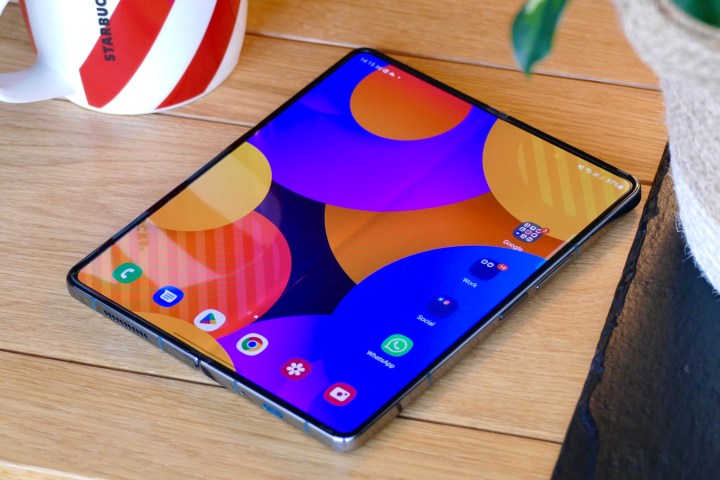
Andy Boxall/Digital Trends
Samsung Galaxy Z Fold 4
Best foldable Android phone
Pros
- Usable cover screen
- Excellent multitasking features
- Inner screen is great for games and video
- Reliable and fun camera
- Water resistant and durable materials
Cons
- Heavy use kills the battery
- Slow charging
Why you should buy this: This is the first folding smartphone that is truly a mass-market product suitable for all users.
Who it’s for: Multitaskers who like the flexibility of a large, but manageable screen.
Why we picked the Samsung Galaxy Z Fold 4:
The Z Fold 4 is the first genuine mass-market folding smartphone, and buyers should be ready to take into account the difference between a flagship folding phone and single-screen or flip phones. The Z-Fold 4 is bulky and heavy at 263 grams and 15.8mm thick — when closed. The exterior has a 6.2-inch Dynamic AMOLED screen featuring a 2316 x 904-pixel resolution and a 120Hz refresh rate. The inside provides a 7.6-inch Dynamic AMOLED screen featuring a 120Hz refresh rate with a 2176 x 1812 resolution.
The Galaxy Z Fold 4 runs on Google’s Android 12L system and Samsung’s OneUI 4.1.1 interface. It’s powered by a Qualcomm Snapdragon 8+ Gen 1 processor with 12GB of RAM and 256GB, 512GB, or 1TB of internal storage.
The foldable phone is equipped with a 50MP main camera, a 12MP 123-degree wide-angle camera, and a 10MP telephoto camera with 3x optical zoom and 30x digital zoom. Video records at up to 8K at 24 frames per second or 4K at 30 or 60 fps. The phone gives you a Pro mode to assist both stills and video in addition to a night mode, Single Take, and portrait mode. The camera images for both the main and selfie cams are vibrant and colorful without oversaturation.
Multitasking is the standout advantage of this foldable, while a dual-cell 4,400 mAh battery is the weakest part of the package. You don’t get a charger in the box but you do get a USB Type-C cable, and the Z Fold 4 supports 25-watt charging. The phone also supports wireless charging, and the Wireless PowerShare feature will also charge a Qi-compatible device placed on the back of the phone.

Samsung Galaxy Z Fold 4
Best foldable Android phone

Joe Maring/Digital Trends
Samsung Galaxy Z Flip 4
Best flip phone Android phone
Pros
- Flatter design looks and feels fantastic
- Bespoke customization is unmatched
- Excellent main display
- Blazing fast performance
- Good, fun cameras
Cons
- Battery still only lasts a day
- Limited cover screen functionality
Why you should buy this: It is one of the best foldable phones you can buy today.
Who it’s for: It appeals to the user who desires a compact, retro-style flip phone, but with modern-day accouterments.
Why we picked the Samsung Galaxy Z Fold 4:
The Samsung Galaxy Z Flip 4 is retro and revolutionary all at once, and for a folding phone, the Z Flip is as durable as they come. The glass panels and cover screen sport Corning Gorilla Glass Victus, while the frame is Samsung’s Armor Aluminum. The unit is protected by an IPX8 water-resistance rating that tolerates up to 1.5 meters of fresh water for up to 30 minutes, but there’s no dust resistance.
When opened, the Z Flip 4 shows a 6.7-inch Dynamic AMOLED 2X panel with a 2640 x 1080-pixel resolution, HDR10+, 1,200 nits of peak brightness, and a variable refresh rate that scales up to 120Hz. Colors are vibrant with wide viewing angles. The cover screen is a 1.9-inch Super AMOLED with 512 x 260 resolution. It runs on Qualcomm’s latest Snapdragon 8+ Gen 1. The camera system is fairly basic, offering a 12MP primary camera, a 12MP ultrawide camera, and a 10MP selfie camera.

Samsung Galaxy Z Flip 4
Best flip phone Android phone
Frequently Asked Questions
Which brands make the best Android phones?
We’ve highlighted Samsung a lot above, and Samsung does make some of the best phones. But it depends on your price range. Samsung is the king of the higher Android price bracket, but head further down, and you start to notice the Google Pixels and other more modest budget models. The bigger names you recognize should definitely be preferred, as quality can be an issue when you start experimenting with obscure brands.
That said, you should not base a buying decision solely on a brand name, as any manufacturer can make a bad phone. Instead, check out individual phone reviews, and decide that way.
How do you choose the right Android phone for your needs?
Price, screen size, camera capabilities, durability, and processing power are some of the most important factors to consider when buying a phone. If you work or game on your phone, you’ll want a device with speedy processing. If you take a lot of pictures or videos, the camera might be a make-or-break factor for you.
How do Android phones differ from iPhones?
Android phones run on the Android operating system, while iPhones run on iOS. But this is only the beginning. Android phones typically offer USB-C charging, while Apple phones use Lightning chargers, at least for now. Users praise Apple for its clean interface, lack of bloatware, privacy, and ease of integration with other Apple devices. Users praise Android for its easy customization, integration with Windows and other devices, affordability, expansion, and innovation.
How long should an Android phone last?
Most modern smartphones should last at least three years, and ideally up to five years. Google and Samsung both promise multiple years of updates and security patches.
Which Android Phone has the best camera?
Many Android phones offer exceptional cameras, including Google’s Pixel 6a, which we named the best camera-value Android phone in this list. The Samsung Galaxy S22 Ultra and the Google Pixel 7 also have stellar camera systems, producing some of the best photos you can get out of a smartphone.
Which Android phone has the best battery life?
A good phone’s battery should last you most of the day, and all the phones on this list meet that standard. However, be aware that high-intensity games, constant music or media streaming, videoconferencing, and other activities that work the processor will cause battery drain sooner. Note too that battery size is only one component of longevity. Most smartphone batteries are optimized to work with the phone’s hardware and software for optimal performance.
Editors’ Recommendations
Credit: Source link



Comments are closed.